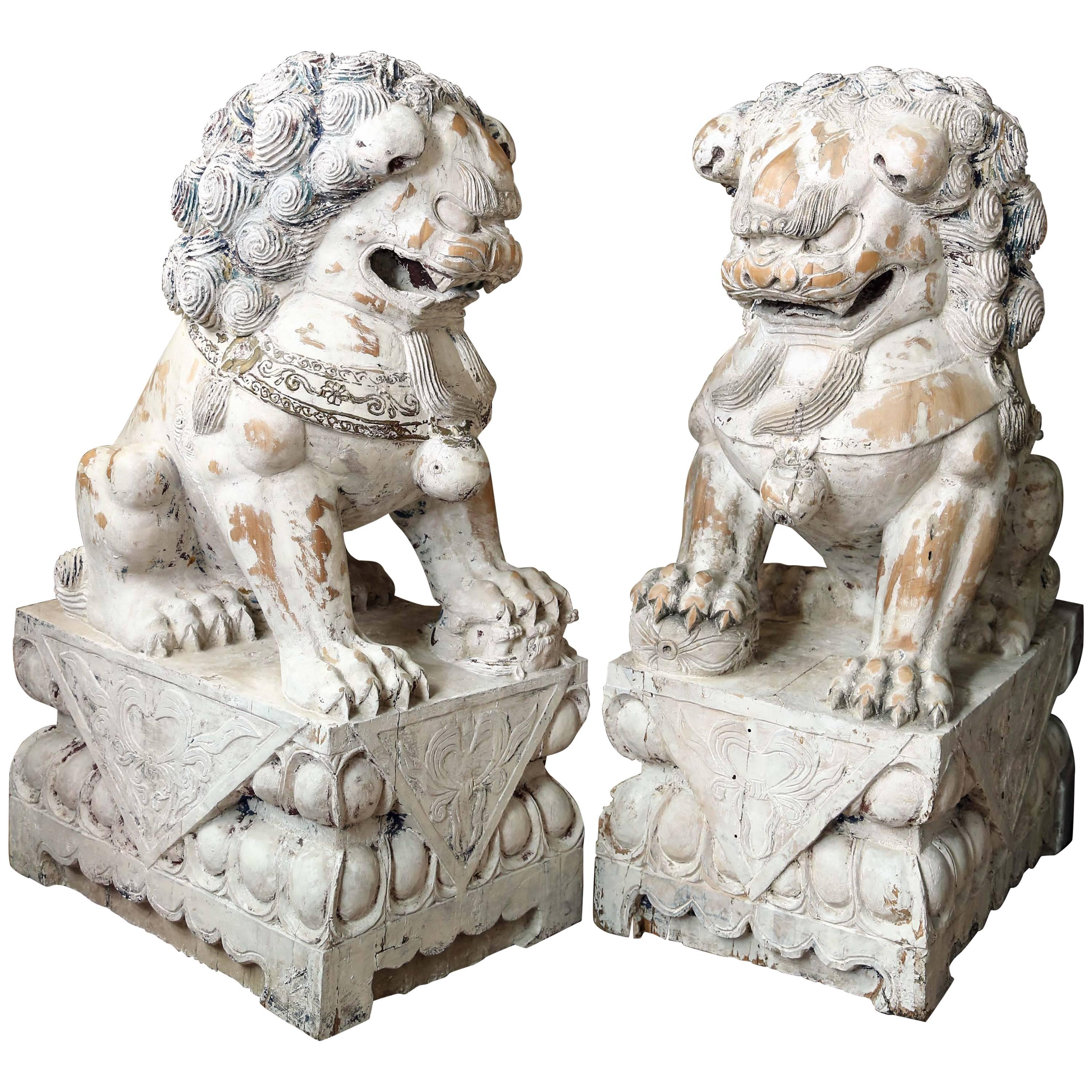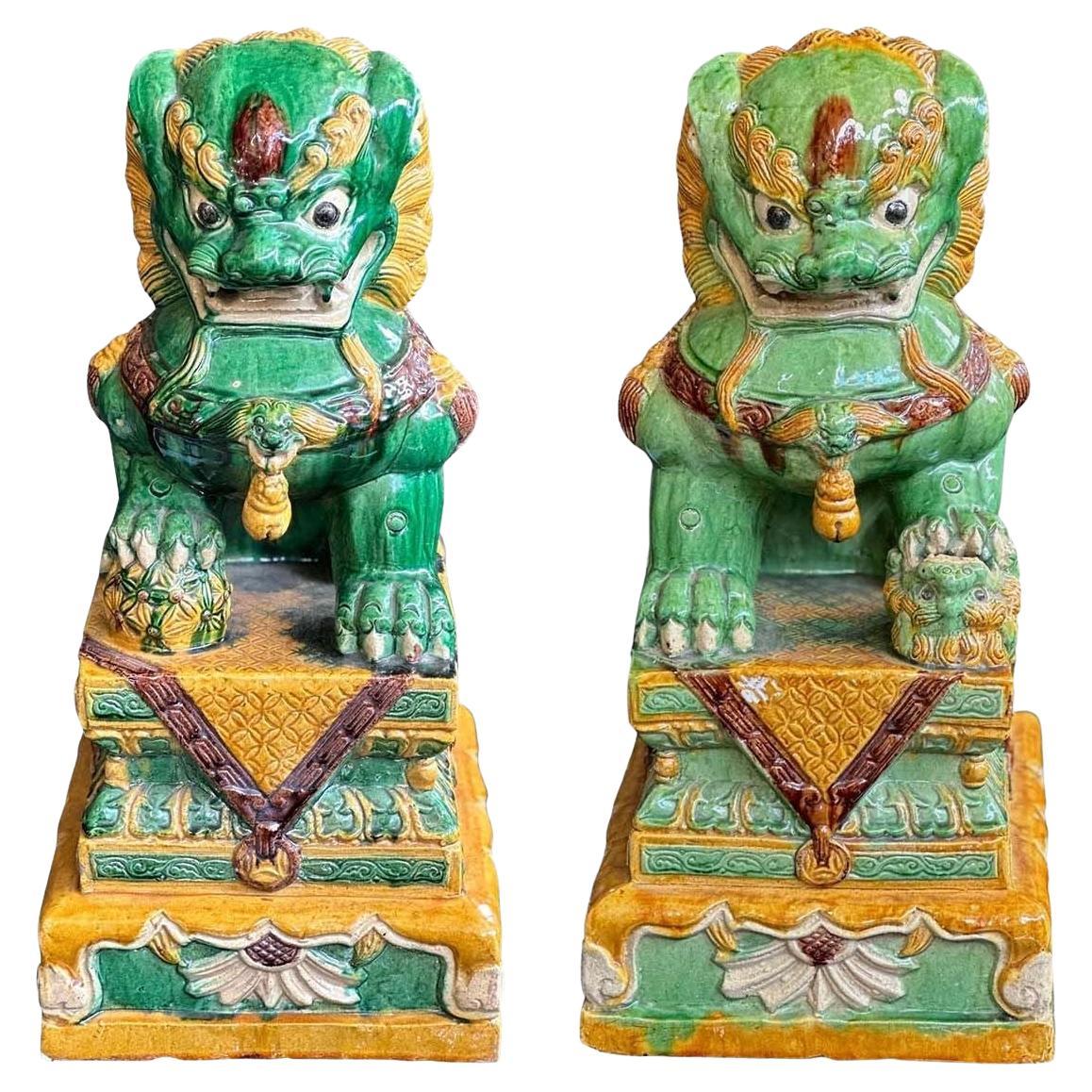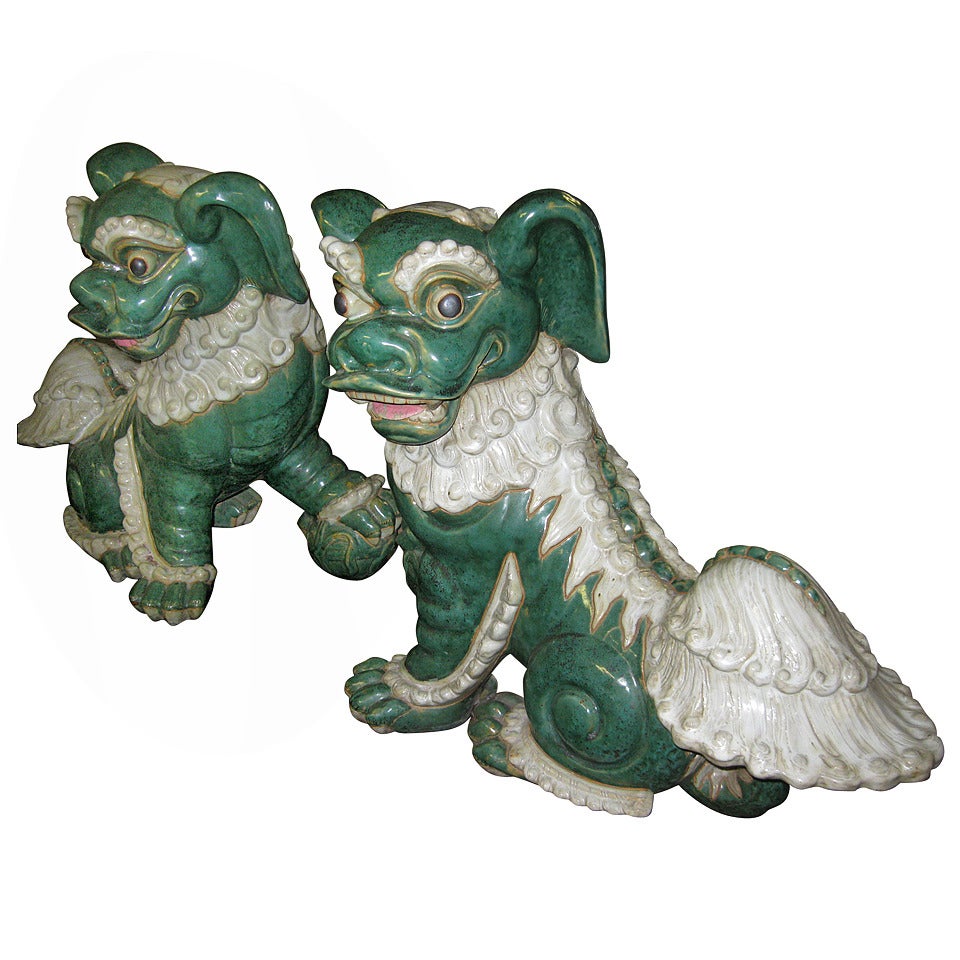Items Similar to Pair of 19th C. Tibetan Carved Wood & Polychromed Foo/ Guardian /Temple Dogs
Want more images or videos?
Request additional images or videos from the seller
1 of 14
Pair of 19th C. Tibetan Carved Wood & Polychromed Foo/ Guardian /Temple Dogs
About the Item
A unique and enchanting pair of 19th Century Tibetan carved wood & polychromed foo/guardian/temple dogs. These mythical Buddhist temple dogs, also known as "foo dogs" or "lion dogs," are beautifully executed, offer a sense of history and spirituality.
Each figure carries a warm and worn patina, a testament to the age and the journey through time. Despite their age, they remain structurally sound, reflecting the craftsmanship and durability of the artisans.
The taller figure features a closed mouth and has graduating carved horns, adding an air of regal poise to its appearance. It stands at a height of 13 inches, with a width of 10 inches and a depth of 7 inches.
The smaller figure has a closed mouth and stands at a height of 12 inches. It measures 9 inches in width and 7 inches in depth, complementing the larger figure in both size and design.
These Tibetan temple dogs are symbolic guardians, representing protection, strength, and spiritual significance in Buddhist culture. Their presence is believed to ward off negative energy and bring good fortune.
As a pair, these 19th Century Tibetan carved wood & polychromed foo/guardian/temple dogs create a harmonious and powerful aura, carrying the essence of ancient traditions.
- Dimensions:Height: 13 in (33.02 cm)Width: 10 in (25.4 cm)Depth: 7 in (17.78 cm)
- Style:Tibetan (Of the Period)
- Materials and Techniques:
- Place of Origin:
- Period:
- Date of Manufacture:19th Century
- Condition:Wear consistent with age and use.
- Seller Location:West Palm Beach, FL
- Reference Number:
About the Seller
5.0
Platinum Seller
These expertly vetted sellers are 1stDibs' most experienced sellers and are rated highest by our customers.
Established in 1996
1stDibs seller since 2017
1,087 sales on 1stDibs
Typical response time: 1 hour
- ShippingRetrieving quote...Ships From: West Palm Beach, FL
- Return PolicyA return for this item may be initiated within 2 days of delivery.
More From This SellerView All
- Pair Chinese Carved Hardwood Foo dogs with Rolling Pearls & Puzzle BallsLocated in West Palm Beach, FLPair of Chinese Carved Hardwood figure of Foo dogs with Rolling 'Pearls' & Puzzle Balls China Mid 20th Century A fine pair of Chinese carved hardwood figures of Foo dogs from mid-20th century China. These exquisite hand-carved wooden Foo dogs display the exceptional craftsmanship of Chinese artisans. Each Foo dog is well carved, capturing the regal and protective essence of these revered guardian lions. Adding to their allure, these Foo dogs feature a unique and captivating detail: a rolling wood...Category
20th Century Chinese Chinese Export Sculptures and Carvings
MaterialsHardwood
- Fine Pair of Chinese Export Marble Seated Foo DogsLocated in West Palm Beach, FLFine pair of Chinese Export marble seated foo dogs, well carved, the male standing 26-inches high, the female 25.5-inches high, beautiful weathered patina....Category
20th Century Chinese Chinese Export Garden Ornaments
MaterialsMarble
- 19th Chinese Carved Hardwood Figure of an Immortal Holding a BatLocated in West Palm Beach, FL19th Chinese carved hardwood figure of an immortal holding a bat, well carved with inlaid bone eyes and teeth.Category
Antique Late 19th Century Chinese Chinese Export Sculptures and Carvings
MaterialsBone, Hardwood
- Tibetan Bronze Standing Gilt Bronze Buddha Offering ProtectionLocated in West Palm Beach, FLTibetan bronze standing gilt bronze buddha offering protection China, 20th century A fine example, the Buddha standing on lotus base with the "no fear" abhaya mudra, the figure is ...Category
20th Century Chinese Chinese Export Sculptures and Carvings
MaterialsBronze
- Large Pair of Chinese Export Sancai Glazed Foo DogsLocated in West Palm Beach, FLLarge Pair of Chinese Export Sancai Glazed Foo Dogs China, 20th Century An exquisite, large-scale Sancai glazed pair of Foo Dogs, featuring elaborately decorated Foo Dogs with rema...Category
20th Century Chinese Chinese Export Ceramics
MaterialsPottery
- Chinese Export Hardwood Carved Plaque of Quan Yin in LandscapeLocated in West Palm Beach, FLChinese Export Hardwood Carved Plaque of Quan Yin in Landscape China, circa 1920s Expertly hand carved landscape plaque of Quan Yin the Buddhist goddess of compassion, mercy, and healing and the eternal protector of women and children. Mounted with symbolic brass hook. Overall measurements : 15-Inches high to the the top of the hook/ 14-Inches high to the top of the hand carved wood plaque...Category
20th Century Chinese Chinese Export Sculptures and Carvings
MaterialsBrass
You May Also Like
- A pair of 19th Century carved Foo temple dogs or Chinese guardian LionsLocated in London, GBChinese guardian lions, or imperial guardian lions, are a traditional Chinese architectural ornament. Typically made of stone, they are also known as stone lions or shishi (石獅; shíshī). They are known in colloquial English as lion dogs or foo dogs / fu dogs. The concept, which originated and became popular in Chinese Buddhism, features a pair of highly stylized lions—often one male with a ball and one female with a cub—which were thought to protect the building from harmful spiritual influences and harmful people that might be a threat. Used in imperial Chinese palaces and tombs, the lions subsequently spread to other parts of Asia including Japan (see komainu), Korea, Philippines, Tibet, Thailand, Myanmar, Vietnam, Sri Lanka, Nepal, Cambodia, Laos, and Malaysia. There has been extensive interaction between Chinese mythology and Confucianism, Taoism, and Buddhism. Elements of pre-Han dynasty mythology such as those in Classic of Mountains and Seas were adapted into these belief systems as they developed (in the case of Taoism), or were assimilated into Chinese culture (in the case of Buddhism). Elements from the teachings and beliefs of these systems became incorporated into Chinese mythology. For example, the Taoist belief of a spiritual Paradise became incorporated into mythology as the place where immortals and deities used to dwell. Sometimes mythological and religious ideas have become widespread across China's many regions and diverse ethnic societies. In other cases, beliefs are more limited to certain social groups, for example, the veneration of white stones by the Qiang. One mythological theme that has a long history and many variations involves a shamanic world view, for example in the cases of Mongolian shamanism among the Mongols, Hmong shamanism among the Miao people, and the shamanic beliefs of the Qing dynasty from 1643 to 1912, derived from the Manchus. Politically, mythology was often used to legitimize the dynasties of China, with the founding house of a dynasty claiming a divine descent. Mythology and philosophy. Further information: Chinese philosophy True mythology is distinguished from philosophical treatises and theories. Elaborations on the Wu Xing are not really part of mythology, although belief in five elements could appear. The Hundred Schools of Thought is a phrase suggesting the diversity of philosophical thought that developed during the Warring States of China. Then, and subsequently, philosophical movements had a complicated relationship with mythology. However, as far as they influence or are influenced by mythology, divides the philosophical camps into two rough halves, a Liberal group and a Conservative group. The liberal group being associated with the idea of individuality and change, for example as seen in the mythology of divination in China, such as the mythology of the dragon horse that delivered the eight bagua diagrams to Fu Xi, and methods of individual empowerment as seen in the Yi Jing (Book of Changes). The Liberal tendency is towards individual freedom, Daoism, and Nature. The relationship of the Conservative philosophies to mythology is seen in the legendary Nine Tripod Cauldrons, mythology about the emperors and central bureaucratic governance, Confucianism, written histories, ceremonial observances, subordination of the individual to the social groups of family and state, and a fixation on stability and enduring institutions. The distinction between the Liberal and Conservative is very general, but important in Chinese thought. Contradictions can be found in the details, however these are often traditional, such as the embrace by Confucius of the philosophical aspects of the Yi Jing, and the back-and-forth about the Mandate of Heaven wherein one dynasty ends and another begins based according to accounts (some of heavily mythological) where the Way of Heaven results in change, but then a new ethical stable dynasty becomes established. Examples of this include the stories of Yi Yin, Tang of Shang and Jie of Xia or the similar fantastic stories around Duke of Zhou and King Zhou of Shang. Mythology exists in relationship with other aspects of society and culture, such as ritual. Various rituals are explained by mythology. For example, the ritual burning of mortuary banknotes (Hell Money), lighting fireworks, and so on. A good example of the relationship of Chinese mythology and ritual is the Yubu, also known as the Steps or Paces of Yu. During the course of his activities in controlling the Great Flood, Yu was supposed to have so fatigued himself that he lost all the hair from his legs and developed a serious limp. Daoist practitioners sometimes incorporate a curiously choreographed pedal locomotion into various rituals. Mythology and practice, one explains the other: in these rituals, the sacred time of Yu merges with the sacral practice of the present. Various ideas about the nature of the earth, the universe, and their relationship to each other have historically existed as either a background or a focus of mythologies. One typical view is of a square earth separated from a round sky by sky pillars (mountains, trees, or undefined). Above the sky is the realm of Heaven, often viewed of as a vast area, with many inhabitants. Often the heavenly inhabitants are thought to be of an "as above so below" nature, their lives and social arrangements being parallel to those on earth, with a hierarchical government run by a supreme emperor, many palaces and lesser dwellings, a vast bureaucracy of many functions, clerks, guards, and servants. Below was a vast under ground land, also known as Diyu, Yellow Springs, Hell, and other terms. As time progressed, the idea of an underground land in which the souls of the departed were punished for their misdeeds during life became explicit, related to developments in Daoism and Buddhism. The underground world also came to be conceived of as inhabited by a vast bureaucracy, with kings, judges, torturers, conductors of souls, minor bureaucrats, recording secretaries, similar to the structure of society in the Middle Kingdom (earthly China). Chinese temple Dogs...Category
Antique 1860s Chinese Chinese Export Sculptures and Carvings
MaterialsHardwood
- Pair of Large Carved Wood Foo DogsLocated in West Palm Beach, FLPair of large & impressive carved Chinese foo dogs.Category
20th Century Chinese Sculptures and Carvings
MaterialsWood
- Pair of Carved Wood Painted Foo DogsLocated in West Palm Beach, FLVery large pair of Chinese carved wood foo dogs. Beautiful patina of worn painted finish.Category
20th Century Chinese Sculptures and Carvings
- Pair of Chinese 19th Century Hand Carved and Painted Temple Guardian LionsLocated in Yonkers, NYA pair of Chinese sculpted and polychromed temple guardian lions architectural wood carvings. Born in China during the 18th or 19th century, each...Category
Antique 19th Century Chinese Sculptures and Carvings
MaterialsWood
- Pair of Late 19th Century Chinese Porcelain Foo DogsLocated in Los Angeles, CAPair of Chinese porcelain male and female foo dogs. The male foo dog seems to have a ball on his foot while the female has a baby foo dog on hers. Made in...Category
Antique Late 19th Century Chinese Sculptures and Carvings
MaterialsPorcelain
- Late 19th century Pair of Glazed Porcelain Foo DogsLocated in Savannah, GAExtraordinary pair of fine glazed porcelain Foo dogs came to us out of an estate here in Savannah, Georgia, belonging to an old general that long ago brought them from Thailand. Used...Category
Antique 1890s Chinese Qing Sculptures and Carvings
MaterialsPorcelain
Recently Viewed
View AllMore Ways To Browse
Chinese Art Rock
Tall Asian Display Stand
Small Bronze Dragon Sculptures
Burmese Shrine
Thailand Demon
Antique Carved Soapstone Vase
Garuda Carving
Seven Lucky Gods
Used Butsudan
Gilt Bronze Monk
Jade Bi Pendant
Han Dynasty Lady
Japanese Bronze Monkey
Dancing Apsara
Fox Shrine
Japanese Wooden Dolls Vintage
Asian Warrior Statue
Bamboo Crescent





